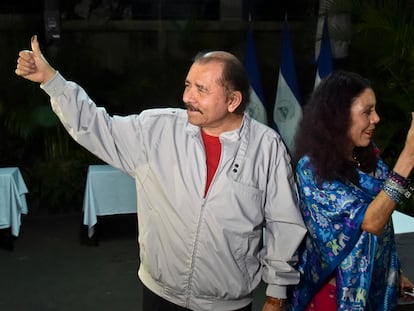Exiles, arrests and 740 attacks: Nicaragua redoubles its persecution of the Catholic Church
The detention of Bishop Isidro Mora is the latest attack in the country, which also recently expelled a group of priests being held as political prisoners


The Nicaraguan regime of President Daniel Ortega and his wife, “co-president” Rosario Murillo, is stepping up its attacks on the Catholic Church. On Wednesday, December 20, the Nicaraguan police intercepted Bishop Isidro del Carmen Mora Ortega, when he was on his way to officiate the confirmations of 230 parishioners in the Santa Cruz parish, located in La Cruz de Río Grande, a remote municipality in the South Caribbean Coast. The bishop was arrested, and his whereabouts are still unknown.
This is the latest episode of persecution against the Catholic Church in Nicaragua, where attacks have escalated over the past year. Since 2018 — when mass protests against the government broke out — the Catholic Church in Nicaragua has suffered 740 attacks by the Sandinista regime, according to Martha Patricia Molina, a Nicaraguan lawyer and author of the study Nicaragua: A Persecuted Church?.
“In 2023 alone, 275 attacks were carried out. We can say this last year was the year with the most attacks against the Church during the recent five-year period,” Molina tells EL PAÍS. In addition, “176 religious men and women are not exercising their ministry in Nicaragua because they were expelled, prohibited from entering or sent into exile.”

The most recent case of this occurred last October, when a dozen priests being held as political prisoners were removed from jail and sent on a plane to Rome. However, this tactic dates back to 2018, when the Ortega-Murillo regime forced the auxiliary bishop of Managua, Monsignor Silvio Báez — one of the most critical voices in the Church against Nicaragua’s authoritarian drift and human rights violations — into exile. Father Edwin Román, a parish priest who was key in protecting citizens from repression in the city of Masaya during the 2018 protests, was also exiled.
In March 2022, the Nicaraguan government also expelled the Vatican nuncio, Waldemar Stanislaw Sommertag. The Holy See described the expulsion of its representative in Nicaragua as surprising and painful. From that moment on, relations between Managua and the Vatican continued to decline, to the point where last March, the Ortega-Murillo regime decided to “suspend diplomatic relations” with the Vatican. The persecution of the Catholic Church in Nicaragua even forced Pope Francis to break with the Vatican’s policy of neutrality. In a statement in March this year, he compared the Nicaraguan government to “the Hitler dictatorship of 1935.” “With much respect, I have no choice but to think that the person who leads [Daniel Ortega] is unstable,” he added, further angering the presidential couple.
All types of attacks and desecrations
A timeline of the persecution against the Catholic Church, put together by EL PAÍS, includes attacks against priests and bishops, church desecrations, the forced closure of media outlets and NGOs managed by the dioceses, the freezing of bank accounts and a sustained narrative against the Catholicism and its leaders. For example, on January 24, 2022, Murillo called priests “retarded and backward,” arguing they “disguise themselves with masks and supposedly elegant costumes.”
“The figures before 2022 range between 55 and 84 attacks. Subsequently, the year 2022 was classified as the worst year for the Catholic Church, since 171 attacks were committed. We didn’t imagine that this year, 2023, was going to be even worse than 2022, since in this period, 275 attacks have already been committed against the religious institution,” says Molina.
This Easter, the regime’s police cracked down on believers and priests, with processions in Nicaragua expressly prohibited. Similar bans were also enforced throughout the year, including on the Conception of Mary procession in early December, when Nicaragua celebrates its national saint.

“To date, a total of 3,639 popular pious expressions, that is, processions, have been banned throughout the country,” says Molina. “The objective of this persecution is always the same: to make the Catholic Church of Nicaragua completely disappear, because priests and bishops have not knelt down before the dictatorship nor have they become accomplices and cronies, which that is what they were hoping for.”
She continues: “They do not want prophetic voices that constantly remind them — through the promulgation of the word and the gospel — of all the criminal acts that the dictatorship has been committing. So, since they have not managed to make bishops and priests bow down to the dictatorial project, the objective is to annihilate Catholicism, to create their own religion, in which the gods are Daniel Ortega and his wife.”
The bishops of the Episcopal Conference of Nicaragua tried to mediate in the sociopolitical crisis of 2018 and then, after the rise in government brutality at the hands of police and paramilitary groups, they decided to show solidarity with the victims. The ruling party did not forgive that decision and on July 19, 2018, in the middle of “operation cleanup” — as the massacres perpetrated by the paramilitaries were known — Ortega publicly accused the bishops of being “coup plotters.” Since then, the attacks against the Catholic Church have continued to escalate.
Despite the regime’s crusade against Catholicism — the country’s main religion — believers continue to regularly attend church. However, self-censorship prevails. Molina recognizes that worshipers are afraid, but have decided to keep practicing their religion.
“Religious vocations also continue, and new priests are always being trained. The dictatorship wanted for the parishioners to turn their backs on the Catholic Church, but they have not achieved this, and they are not going to achieve it either,” says Molina, who lives in exile.
Meanwhile, among many worshipers, especially in rural parishes, terror reigns. “We don’t know anything about the monsignor [Bishop Isidro del Carmen Mora Ortega] and we fear that they have transferred him to the El Chipote prison, and you know: in that place they torture,” a woman from the diocese of Siuna, who does not wish to give her name, tells EL PAÍS. “Monsignor’s sin,” she continues, was mentioning Rolando Álvarez, the first bishop arrested and sentenced to 26 years in prison by the Sandinista regime. “He said that the bishops of the Episcopal Conference of Nicaragua were praying for Bishop Álvarez and the day after that, well, they kidnapped him. The government does not want anyone to denounce what happens to Catholics.”
Sign up for our weekly newsletter to get more English-language news coverage from EL PAÍS USA Edition
Tu suscripción se está usando en otro dispositivo
¿Quieres añadir otro usuario a tu suscripción?
Si continúas leyendo en este dispositivo, no se podrá leer en el otro.
FlechaTu suscripción se está usando en otro dispositivo y solo puedes acceder a EL PAÍS desde un dispositivo a la vez.
Si quieres compartir tu cuenta, cambia tu suscripción a la modalidad Premium, así podrás añadir otro usuario. Cada uno accederá con su propia cuenta de email, lo que os permitirá personalizar vuestra experiencia en EL PAÍS.
¿Tienes una suscripción de empresa? Accede aquí para contratar más cuentas.
En el caso de no saber quién está usando tu cuenta, te recomendamos cambiar tu contraseña aquí.
Si decides continuar compartiendo tu cuenta, este mensaje se mostrará en tu dispositivo y en el de la otra persona que está usando tu cuenta de forma indefinida, afectando a tu experiencia de lectura. Puedes consultar aquí los términos y condiciones de la suscripción digital.
More information
Archived In
Últimas noticias
Most viewed
- Sinaloa Cartel war is taking its toll on Los Chapitos
- Oona Chaplin: ‘I told James Cameron that I was living in a treehouse and starting a permaculture project with a friend’
- Reinhard Genzel, Nobel laureate in physics: ‘One-minute videos will never give you the truth’
- Why the price of coffee has skyrocketed: from Brazilian plantations to specialty coffee houses
- Silver prices are going crazy: This is what’s fueling the rally










































